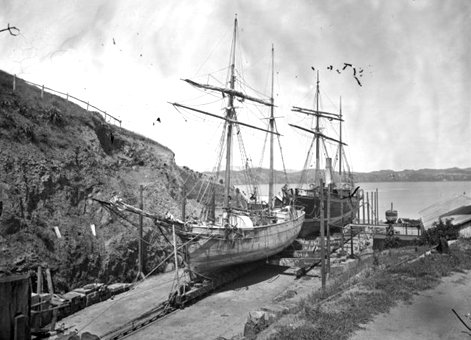John Tiffin Stewart was born in Rothsey, Isle of Bute, Scotland on 18 November 1827. He was the third son of a sea captain and learned sailing and navigation aboard his father’s vessel.

Schooner Julius Vogel and steamship Grafton on the patent slip, Evens Bay, Wellington, Maplesden, Peter Wilson; Negatives of Evens Bay slip. Ref; 10x8-1825-G..
Stewart went to school in Rothsey before attending the University of Glasgow, where he graduated as a civil engineer in 1850. He got further training under Professor Rankine and others until 1852.
After immigrating to Australia and living in Victoria for three years, Stewart moved to New Zealand. Initially he joined two of his brothers farming at Raglan, before commencing a long career of land surveying, initially in the Waikato region.
In 1857 Stewart traversed and mapped the Manawatu, Pohangina and Oroua Rivers from their mountain sources to the sea. Appointed as an Assistant Surveyor by the colonial government in late 1858, he then began surveying Māori land.
Stewart’s first such survey was within the area bounded by the Oroua River and the Ruahine and Tararua ranges. During this survey, he saw and recommended the site for Palmerston North. After the Manchester Block was purchased from Ngāti Raukawa, he was sent back to lay out the town. Stewart was also involved in the surveying of Feilding, Halcombe and Rongotea townships and others within the block. Similar foresight is apparent in their planning, including the provision of large central squares.
In 1861 he became Wellington Provincial Engineer. Projects he designed included Queens wharf, the patent slip at Evans Bay, and reclamation of parts of the harbour in what is now central Wellington. He subsequently advised on other marine works elsewhere in New Zealand.
From 1864 he was responsible for roading in the Manawatu area. When the colonial government established its Public Works and Immigration Department in 1870 Stewart was appointed District Engineer, Foxton. Projects included construction of the Palmerston North to Woodville road through the Manawatu Gorge (1871–72).
From 1885 until his retirement in 1889 he was District Engineer, Wanganui. During this period Stewart was responsible for the construction of the government railway from Foxton to Whanganui. In 1885 he prepared a report on snagging and making the Whanganui River navigable. Between 1891 and 1909, Stewart was the Wanganui River Trust’s honorary chairman (1891–98), and honorary engineer. This work enabled river steamers to travel as far inland as Taumarunui.
Stewart’s interests extended to church welfare institutions, arts and commerce, and while in Whanganui he actively encouraged these. He was also noted for his interest in astronomy. The gardens at Virginia Water, Whanganui, were another public asset planned by him.
Stewart died 19 April 1913, three years before his wife. Upon her death, the family home in Whanganui was bequeathed to the Plunket Society as a Karitane training hospital.
Find out more
Further reading
“A man for all seasons”, [open in new tab] Whanganui Regional Museum, accessed 24 August 2015.
A Kirk, “Stewart, John Tiffin – Biography”
http://www.teara.govt.nz/en/biographies/2s46/stewart-john-tiffin
, from the Dictionary of New Zealand Biography in Te Ara - the Encyclopedia of New Zealand, updated 1 September 2010.FW Furkert, Early New Zealand Engineers, Reed, 1953, pp.272–74.
Barbara Marshall, “John Tiffin Stewart”, Kete Horowhenua, accessed May 2011.
